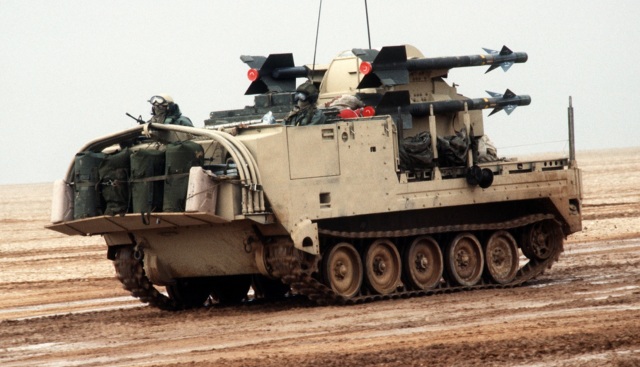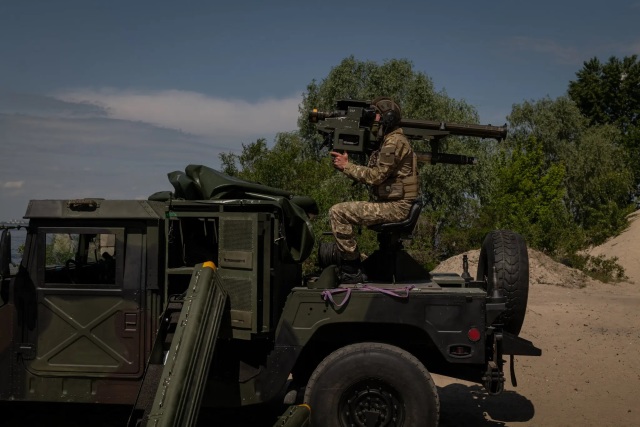The American newspaper "The New York Times" published an interesting article by Lara Jakes "Desperate for Air Defense, Ukraine Pushes U.S. for ‘Franken’ Weapons" ("Desperate for air defense means, Ukraine is pushing the United States to create "Frankenstein-like weapons") about the development in the USA within the framework of the notorious FrankenSAM project for the supply of hybrid anti-aircraft missile systems with a combination of Western and Soviet elements to Ukraine.

The first American "approach" to a ground-based anti-aircraft missile system using guided missiles of the AIM-9 Sidewinder family was the M730A2 combat vehicle of the M48A2 Chapparal anti-aircraft missile system of the US Army during combat operations against Iraq in the Persian Gulf War in February 1991. The M48 Chapparal complexes were in service with the US Army from 1969 to 1998 (with) the US Army
To satisfy Ukraine's demands, the United States is creating so-called FrankenSAM systems, which combine advanced Western weapons with Soviet-era equipment that are still in Ukrainian arsenals.
With winter approaching, the Ukrainian authorities desperately need to strengthen their air defenses to protect their power grids from Russian strikes that could plunge the country into icy darkness.
Out of desperation, Ukrainians are ready to experiment with monstrous weapons systems that were loaned by Ukraine and that the Pentagon is currently developing.
American officials call it the FrankenSAM program, which combines modern Western anti-aircraft guided missiles with upgraded Soviet-era launchers or radars that the Ukrainian armed forces already have. Two versions of this improvised air defense system - one of the Soviet Buk missile launchers and American Sea Sparrow anti-aircraft missiles, the other with Soviet-era radar and American Sidewinder missiles - have been tested over the past few months at military facilities in the United States and should be delivered to Ukraine by the end of the year, as reported officials.
The third variant, the Cold War-era HAWK air defense system, which was first demonstrated in combat operations in Ukraine this week, became an example of what a senior representative of the US Department of Defense, Laura K. Cooper, described this month as a "resurrected" part of FrankenSAM, an air defense relic brought back to life.
Together, the FrankenSAM air defense systems "contribute to filling critical gaps in Ukraine's air defense, and this is the most important task that Ukraine faces today," said Cooper, Deputy Assistant Secretary of Defense for Russia, Ukraine and Eurasia Policy.
Almost from the very beginning of the war, Ukraine has been trying to combine offensive weapons - its aging Soviet-era stocks and those it received from the West - in unexpected, but in many cases successful ways. Last year, US military representatives spoke with admiration about Ukraine's ability to use its "arsenal of MacGyver" - a metaphor for a 1980s TV show in which the main character uses simple, improvised devices to get out of unpleasant situations.
The FrankenSAM project is now trying to do the same for the air defense of Ukraine.
Over the past 20 months, the West has supplied Ukraine with a number of air defense systems, including the latest Patriot and IRIS-T air defense systems, anti-aircraft self-propelled guns, and more than 2,000 portable Stinger missiles.
Last week, German Chancellor Olaf Scholz announced that his government would provide Ukraine with three more batteries of modern air defense systems, including another Patriot system, as part of what he called a "winter package" of assistance worth almost $1.5 billion.
"As winter approaches, we are creating a protective shield against new Russian attacks on the energy, water and heating infrastructure," Scholz said on October 24. - "Because it becomes obvious that Russia will again use the cold and lack of energy as a weapon against the civilian population."
The air defense assets are part of the military assistance worth about $ 100 billion that Ukraine received from the allies after Russia's full-scale invasion in February 2022. The United States, which has already sent more funds to arm Ukraine than any other country individually, is considering allocating another $60 billion. as part of the new emergency spending plan of the administration of US President Joe Biden.
On October 26, the US administration announced the allocation of another $ 150 million in military assistance to Ukraine in the form of an arms package that includes additional anti-aircraft missiles for three types of air defense systems, including Sidewinder missiles for one of the FrankenSAM systems.
Now that Ukraine has Western tanks, armored vehicles, air defense systems and long-range attack missiles in its arsenal, and fighter jets are on the way, officials said that Ukraine largely needs more weapons of the same types that it has already received, and not any new systems.
FrankenSAM are a mixture of both. The origins of the program date back to the end of last year, when Ukrainian officials asked the allies to help them find missiles for about 60 Soviet-made Buk missile launchers and radars that were not used in the Kiev arsenal. Realizing that it would be difficult for the West to obtain Russian-made missiles for Buk systems, the Ukrainians, as an alternative, offered to re-equip their launchers to use anti-aircraft missiles of NATO standards transferred by the United States.
"We realized that we need to find some solutions," said the chairman of the commission of the Ukrainian parliament, which oversees the supply of weapons from the West, Alexandra Ustinova. According to her, Ukrainian representatives offered to assemble such weapons independently to save time, "because in winter we urgently need air defense means, and they should be used as much as possible."
But the American developers insisted on doing this work on their own, and it took them more than seven months to test and refine the complex after the Pentagon agreed in January to provide Sea Sparrow missiles for the project. According to Ustinova, the first few repaired launchers of the Buk complex and missiles arrived in Ukraine quite recently.
She said that Ukraine was ready to send 17 more Buk installations to the United States for re-equipment, but American developers can deliver them at a rate of only five units per month.
Ukraine also had to wait for the old HAWK air defense systems to be put into operation after they were originally promised by Spain in October 2022. A month later, the United States announced that it would pay for the repair of old HAWK anti-aircraft missiles for the transferred Spanish complexes. But at least some of them were delivered to Ukraine without the necessary radar equipment. It took another nine months.
By the evening of October 23, 2023, the HAWK air defense systems had reached full combat capability, shooting down targets together with more modern air defense systems, Lieutenant General Nikolay Oleshchuk, commander of the Ukrainian Air Force, said in Telegram. Hitting 100 percent of targets "is not easy, but every day we will get closer to it, strengthening our air defense," General Oleshchuk wrote.
Another creation of the FrankenSAM project - an improvised ground-based launcher that uses Soviet-era radar to launch old American missiles that are usually used on fighter jets - was presented in a $200 million military aid package to Ukraine, which the Pentagon announced on October 11.
At the same time, this FrankenSAM uses supersonic AIM-9M Sidewinder [short-range air-to-air missiles] of American production, which were developed in the 1950s and are used on F-16 and F-18 fighters. Now they are part of an improvised ground-based air defense system, which Cooper presented in Brussels as a "real innovation", and which, according to her, will help accelerate the strengthening of air defense in Ukraine, "instead of, as you know, spending years and years on development." However, it is unclear when exactly these complexes will be delivered to Ukraine.
American military representatives and developers are also still testing perhaps the most powerful FrankenSAM system: the anti-aircraft missile and the Patriot air defense missile launcher, which are integrated with old Ukrainian radar systems of domestic production.
A Pentagon spokesman said on October 25 that an unmanned target was successfully hit during the test launch of this complex, carried out this month at the White Sands missile range in New Mexico. According to the official representative, this complex is planned to be sent to Ukraine this winter along with missiles and other elements of the Patriot air defense system from several US allies.
Jan Kasapogly, a military analyst at the Hudson Institute in Washington, praised the idea of integrating Soviet-era equipment with more advanced Western missiles as a way to help Ukraine "preserve its arsenal in case of an upcoming prolonged war."
It also "makes it possible to put into practical use the weapons that are gathering dust on the shelves in NATO capitals," Kasapogly said.

Used by the Armed Forces of Ukraine in the Kiev air defense system, the Dual Mount Stinger (DMS) support launcher of the American portable air defense system Stinger, mounted on the HMMWV (c) Nicole Tung / The New York Times
